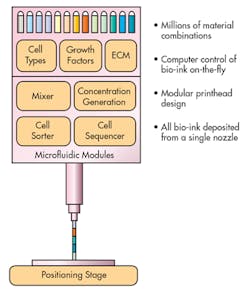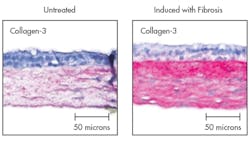The 3DAirwayALI developed by Aspect Biosystems Inc. leverages a single printer head to generate customized human-airway tissues for pharmaceutical testing. The head systematically releases various growth factors, cell types, and extracellular matrix (ECM) to build a tissue layer, and changes parameters as it switches from one layer to the next. The resulting complex tissue is shipped in multi-well plates or other high-quality packaging, and is sustainable for approximately 100 days, enabling it to undergo rigorous pharmaceutical testing.
The 3DAirwayALI printer can be used to create heathy tissue, along with tissue that develops a diseased phenotype, such as pulmonary fibrosis (unhealthy scarring of airway tissue caused by excess generation of fibroblasts in the endothelial layer and stroma). Aspect can print airways at different stages of the disease, so that scientists can study the biological pathways and manifestations in a physiologically accurate model.
Before printing, Aspect employees calculate the timing and rate of release for every component so that the distinct layers of a human airway are present in the sample. For example, they program the printer head to release the correct ratio of extracellular matrix (ECM) to fibroblast cells in the stroma to ensure normal cell proliferation. They also make sure that the ECM contains the proper growth factors so that planted somatic cells (adult stem cells found in fully mature organs) differentiate into the fibroblasts. When printing unhealthy airway tissue, Aspect engineers may introduce abnormal growth factors into the sample to activate fibrosis-inducing genes.
Aspect hopes to develop other tissue products in its next generation of bio 3D printers. It is working on gastrointestinal-tissue and skin printers in its ALI series to enable drug-toxicity and fibrosis research. The ability to print cancerous tissue may eventually facilitate oncology research.


